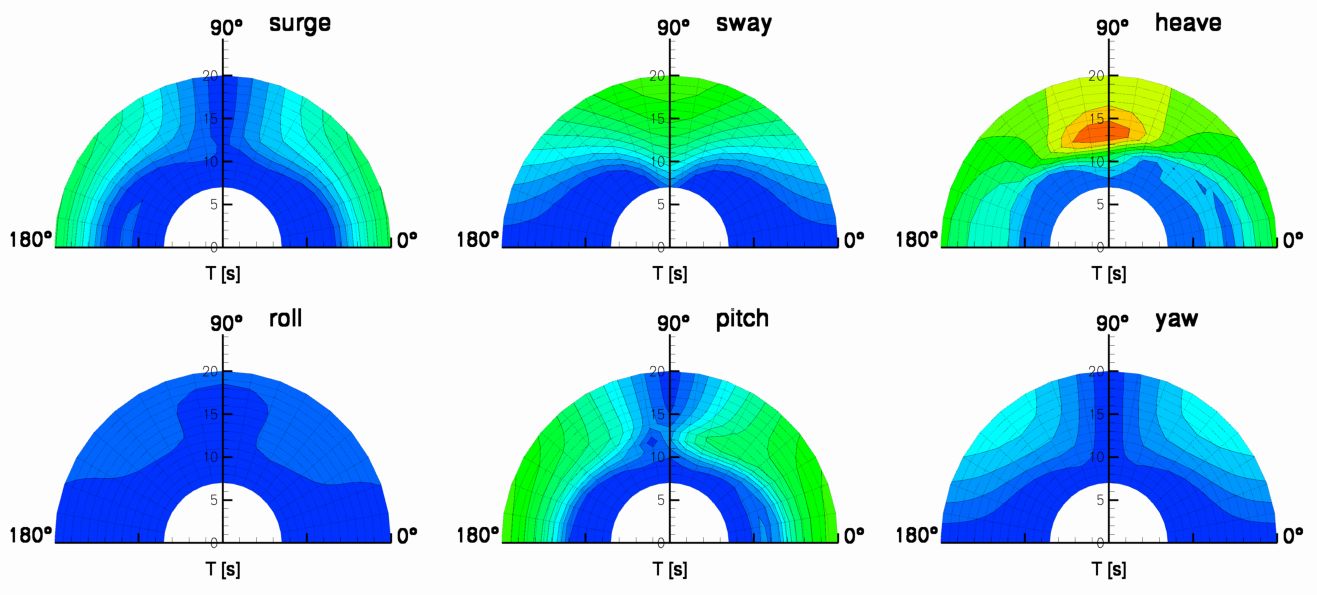Research
HYDROMECHANICS AND DESIGN
|
Dipl.-Ing. Jan Oberhagemann |
Risk-Based Assessment of Seaway-Induced Dynamic Loads of Ship Structures
Hydrodynamic load assumptions in class society rules are mainly founded on empirical experience and quasi-static load application. This causes big uncertainties for the structural dimensioning of new and / or unconventional designs. Moreover, the implemented safety level is hardly quantifiable, and assumed to be inconsistent for different parts of the ship structure.
|
|
B.Sc. Erwin van Heumen |
Dynamic Loads on Propeller Blades
In order to calculate the level of stress in the propeller blades, both the distribution of the hydrodynamic loads and the elastic behaviour of the propeller are to be considered. The load distribution on the propeller is determined by means of RANSE methods on the basis of the sea and manoeuvring conditions. With regard to the elastic behaviour, the propeller of an offshore supply vessel has been modelled as an elastic system by means of finite elements, instead of being a rigid body.
Currently, a procedure is being developed by which the calculated hydrodynamic forces can be transferred to the FE model. One-way as well as two-way fluid structure interactions are to be considered, with the aim to determine the dynamic amplification of the propeller loads.
|
|
Dipl.-Ing. Bastian Röös |
Mat-Roll (Development of numerical methods to determine the roll damping of modern ship hulls) The behaviour at sea and especially the roll damping of a ship are of special importance for the assessment of the safety of a ship. Large roll amplitudes and high accelerations resulting from them put equally the staff and the environment at risk and up until now cause severe damages to a ship and its freight. The aim of the research project is to develop mathematical methods to determine the roll damping at the early stages of the design of a ship. By means of modern numerical methods based on the solution of the Reynolds-averaged Navier-Stokes equations, hydrodynamic data bases of modern ship hulls are being developed, in which the damping coefficients are collected in relation to the dimensions of the ship and to the roll parameters.
On the basis of the hydrodynamic data bases, initially a mathematical model is developed which takes into account the relevance of the individual influencing factors on the roll damping and the coupling of these. Based on this model, the data gained will initially be compared with the values gained from the regression models according to Ikeda and afterwards be subjected to a further regression analysis. From these examinations new, modified regression models are obtained which, in the focus of modern ship hulls and large roll amplitudes, serve as a future tool to assess efficient roll damping during the design of a ship.
|
|
Dipl.-Ing. Jens Ley |
Design for Ship Safety in Extreme Seas
Amongst others, high bending moments and shear forces that are induced by extreme sea states are considered to be a possible cause of total ship losses in the past. Structural responses occur as a result of fluid-structure interaction. In particular, hydro-elasticity is the reason for high dynamic amplifications of the global loads, making a significant contribution to the life-cycle loads. Herein, resonance and slamming are important stochastic effects that must be considered. A better understanding of those dynamic amplifications as well as their probability of occurrence is necessary to assume more proper design loads in the ship design process. Nowadays, in the rules of classification societies these effects are covered by safety factors, based on experience. Therefore, the European project “Extreme Seas” deals with the determination of ship motions and loads in heavy seaways, taking into account hydro-elasticity. The aim is to develop design methods and to optimise and adjust design loads for various types of ships, respectively. Moreover, a better knowledge of the behaviour of extreme waves is an important objective. The main focus of attention here is to increase the safety of ships.
Investigations of the physical properties of extreme waves are performed to improve the existing wave models and to adjust the methods that are used to generate them in numerical simulations. Based on long-term predictions, extreme wave trains that induce extreme ship responses will be determined and numerically investigated. A coupling of an existing RANSE solver with a Finite-Element based code will be carried out to compute the sectional loads. A detailed structural analysis follows and is addressed to global and local loads. At last, the results of these seakeeping simulations will be validated with experimental data. As a consequence, new methods for a risk-based design may be developed or existing ones can be optimised. |
|
Dipl.-Ing. Jens Neugebauer |
Tug powersPrediction of aero and hydrodynamic forces acting on ships navigating on the river Elbe in order to estimate the required tug power As a consequence of an increasing demand for transport volume at sea, there is a recognizable trend towards larger vessels which have larger areas being exposed to wind and current, leading to higher wind and current loads. Thus, it is getting increasingly difficult to determine the required tug power in confined waters. |
|
Dipl.-Ing. Jens Neugebauer |
SQUAT
Within the SQUAT project the Institute of Ship Technology, Ocean Engineering and Transport Systems is calculating the squat of ships as a result of shallow water conditions on the River Elbe. The calculations are performed by means of a Finite Volume Method, which employs the Reynolds-Averaged-Navier-Stokes-Equations (RANSE). Hereby, the influence of the discretization, consideration of viscosity and timestep-size onto the Squat is investigated. The results are being compared to measurement data of the Federal Waterways Engineering and Research Institute (BAW). |
|
Dipl.-Ing. Jens Neugebauer |
The Sloshing-Laboratory of the ISMT
Description The ISMT operates a laboratory for the investigation of sloshing. Sloshing describes the resonant motion of fluids in partly filled cavities. Due to sloshing, fluid cargo tanks, particularly those of oil tankers, LNG-tankers and bulk carriers as well as chemicals and product tankers are exposed to high local and global loading. The industry’s demand to carry goods in partly filled tanks on the one hand and the requirement of appropriate safety regulations on the other hand, require investigations on the behavior of these two-phase-systems within appropriate tanks, which will be carried out mainly experimentally.
|
|
Dipl.-Ing. Sven-Brian Müller |
Manoeuvring behaviour of inland waterway vessels; development of numerical approaches for the determination of the forces of the rudder and the transverse thruster in headway
The increases of transportation on inland waterways as part of complex logistical transport solutions as well as the expanding ship sizes pose a challenge to inland water transport. Beside the widely well developed main waterways like Rhine and Elbe, smaller and less developed rivers providing individual and flexible transport solutions are becoming ever more important. In order to increase safety as well as optimal economical utilisation of the waterway, an accurate prediction of the manoeuvring behaviour of inland waterway vessels is necessary. For the prediction of ships’ manoeuvring the following forces need to be known: ship resistance, propeller thrust, rudder forces and forces of the transverse thruster. The lift and drag of the rudder depend on the rudder angle and the inflow velocity in the propeller slip stream. Also, the ship motions have to be considered. Apart from the rudder, the transverse thruster serves as an active steering device.
|
|
Dipl.-Ing. Sven-Brian Müller |
HyProCon – Influence of scale effects on the hydrodynamic properties of propellers for large container vessels (funded by the Federal Ministry of Economics and Technology (BMWi), Berlin/Germany)
The optimisation of the propulsion system is getting more important. By improving hull shape and geometry of the propeller, an increase of the propulsive efficiency and a decrease of the operating cost can be achieved. Due to the rapid increase of ship size and ship speed particularly in the case of container vessels, the diameter of the appropriate propeller increases correspondingly. Owing to the fact, that the dimensions of the test facilities in the towing tanks are not suitable to cover these ship sizes, the global scale factors increase. With the increase of the scale factors, the significance of extrapolation methods of the measured model results to the full-scale intensifies substantially. The available scaling procedures are applied in a new range, for which only limited experience exists. The aim of the study is the development of an extrapolation method which uses detailed information on the flow behaviour in model and full-scale by use of numerical calculations. For the investigation of the scale effects common propellers for large container ships, all of them developed by Mecklenburger Metallguss GmbH (MMG), were selected.
In order to determine the scale effects, the flow on these propellers in model and full-scale was simulated numerically. The basis for the development of the scaling method was identified by comparing the computed distribution of the pressure and the wall shear stress on model to the full-scale propeller geometries. |
|
Dipl.-Ing. Klemens Hitzbleck |
Determination of design loads for the structural design of ship propellers
The influence of a ship`s motions in seaways on propellers and the stress resulting from manoeuvring processes have not been recorded – neither arithmetically nor metrologically – in a way that would allow load spectra to be determined for the dimensioning of the propeller`s structure. In recent years, propeller designs have changed notably. In addition, podded drives have increasingly found their way into the design of even the largest ships. For these new developments, experienced data are lacking as yet. Within the framework of the European joined project “Propulsion in Seaways” procedures and methods are aimed to be developed to create load spectra for propellers on the basis of the operational profile, the conditions of sea in the cruised area and the typical manoeuvring situations. For this purpose, strain gauges will be installed at a propeller of an offshore supply vessel. The stresses working on the propeller are recorded along with the motor power and the ships motions. Based on these data, a load spectrum can be drawn up for the ship examined and similar ones. The loads affecting the propeller are determined on the basis of the sea state and the geometry of the ship by using numerical methods as well. The results of these calculations are validated on the basis of the measurements and model tests. From the results of measurements, model test and simulation, guidelines and recommendations can be diverted by which propellers can be reliably, dimensioned for different design loads.
Partners of this project in Germany are: University of Hamburg, Develogic GmbH, Germanischer Lloyd AG. In Norway: Research Centre MARINTEK, Norwegian University of Science and Technology, Rolls-Royce Marine AS and Farstad Shipping ASA. |
|
Dipl. Math. Julia Dohmen |
Validation of a CFD-Programme for the simulation of fire spread on container ships
In December 2008, fire tests directed by an industrial partner were carried out in closed and partly open containers. On the basis of these results, knowledge on the spread of fire, the development of temperature and gas composition during a container fire could be gained. In the course of the operation, fire tests were simulated numerically using the FDS- (Fire Dynamics Simulator) programme. The aim of this was to validate the numerical method. Furthermore the options of the CFD-procedure with regard to heat transmission and propagation of fumes in a closed cargo bay are being investigated.
|
|
Dipl. Math. Julia Dohmen |
Simulation with OpenFOAM
OpenFOAM (Open Field Operation and Manipulation) is a free simulation software package for continuum-mechanical problems. It contains a number of standard solvers for different types of physical problems. Additional solvers can be added with the OpenFOAM-internal syntax.
By using OpenFOAM, Ms. Dohmen is engaged in the development and application of numerical procedures for the solution of marine flow problems (e.g. multiphase flows such as free surface and cavitation). For this purpose, Navier-Stokes equations and transport equations are coupled with rigid body equations of movement and solved numerically. The results obtained from these simulations are validated by means of model experiments.
|
|
Dipl.-Ing. Alexander von Graefe |
Project GL Rankine
The project GL Rankine is a cooperation between Germanischer Lloyd and the Institute of Ship Technology, Ocean Engineering and Transport Systems. The project aims at improving a seakeeping code based on potential theory. It is used to calculate the stationary flow around ships with or without deformation of the free water surface, as well as the periodic flow caused by an incident wave and the resulting ship motions and loads.
|

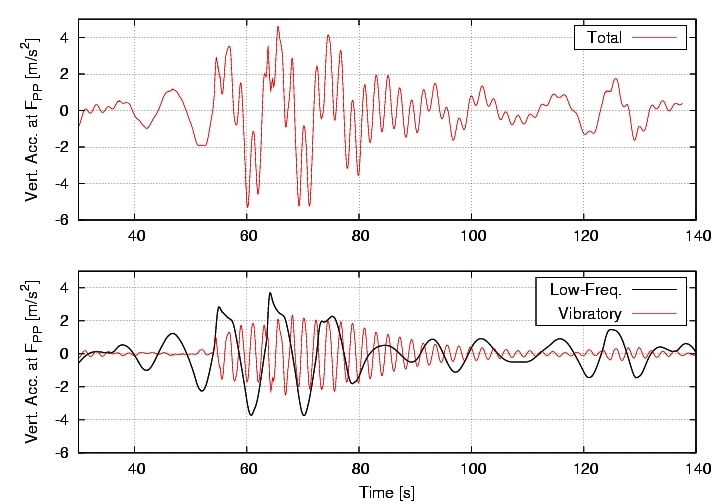
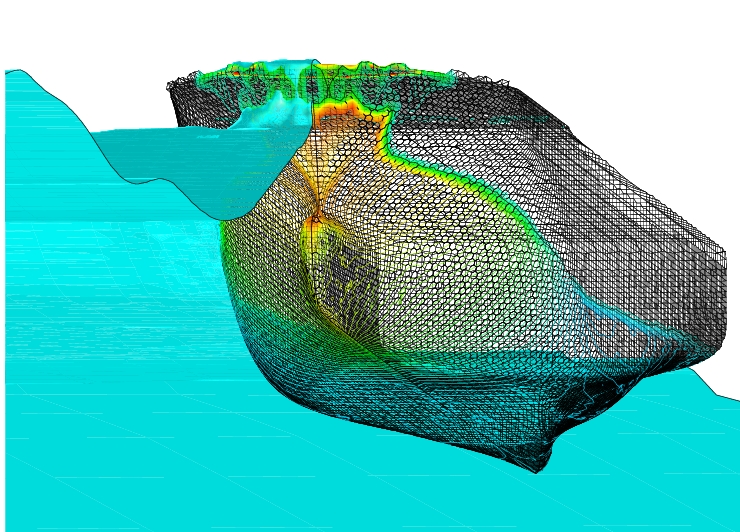
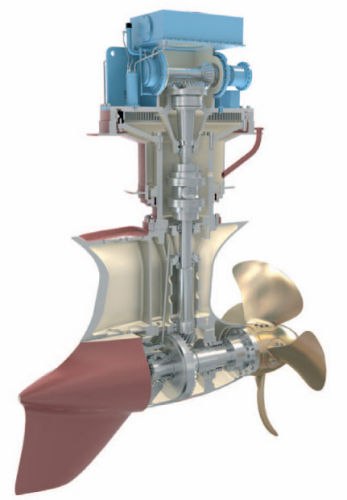 In the sub-project LastProp, which is in the framework of the research project “PROPULSION IN SEAWAYS“ (PropSeas), the stresses in a propeller blade caused by manoeuvring and ship motions in heavy seaways are investigated with numerical methods.
In the sub-project LastProp, which is in the framework of the research project “PROPULSION IN SEAWAYS“ (PropSeas), the stresses in a propeller blade caused by manoeuvring and ship motions in heavy seaways are investigated with numerical methods.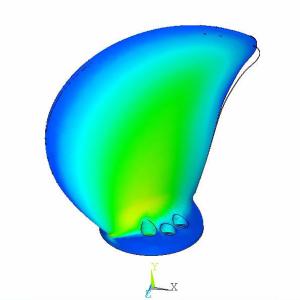 A superposition of elementary load components like thrust, centrifugal and inertia forces due to ship motions was implemented in the FE-Model to calculate the blade deformation and the stresses resulting from it. In order to examine the dynamic behaviour of the propeller, the natural frequencies of the propeller blades were calculated as well as their corresponding mode shapes.
A superposition of elementary load components like thrust, centrifugal and inertia forces due to ship motions was implemented in the FE-Model to calculate the blade deformation and the stresses resulting from it. In order to examine the dynamic behaviour of the propeller, the natural frequencies of the propeller blades were calculated as well as their corresponding mode shapes.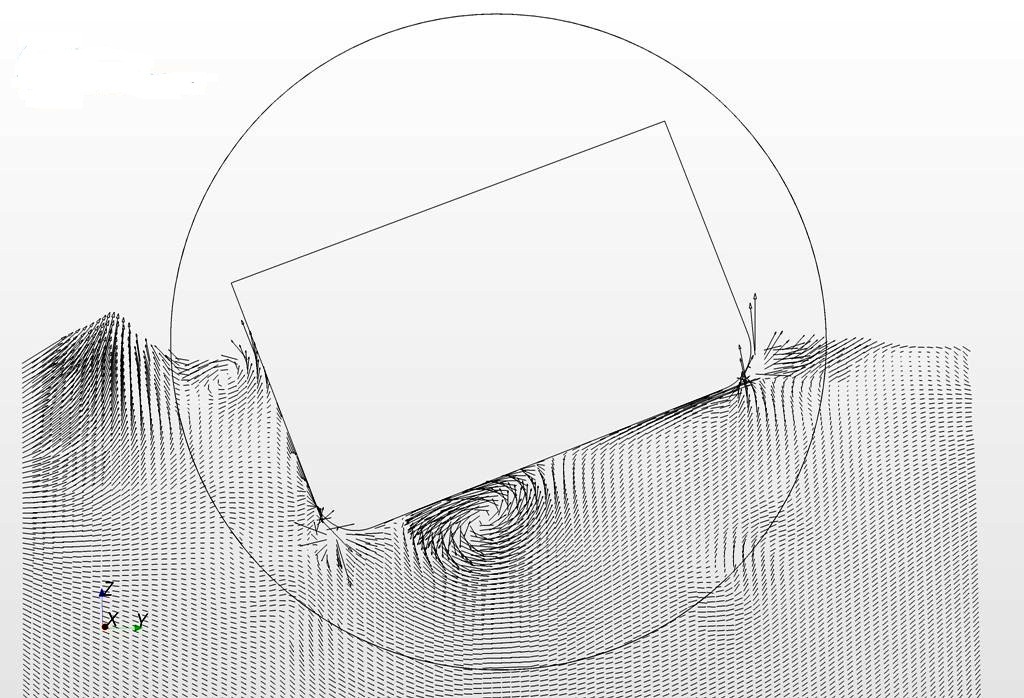 The results of these numerical calculations are being validated by relevant model tests. In the course of this validation, the scale effects on the rolling motion are examined as well.
The results of these numerical calculations are being validated by relevant model tests. In the course of this validation, the scale effects on the rolling motion are examined as well.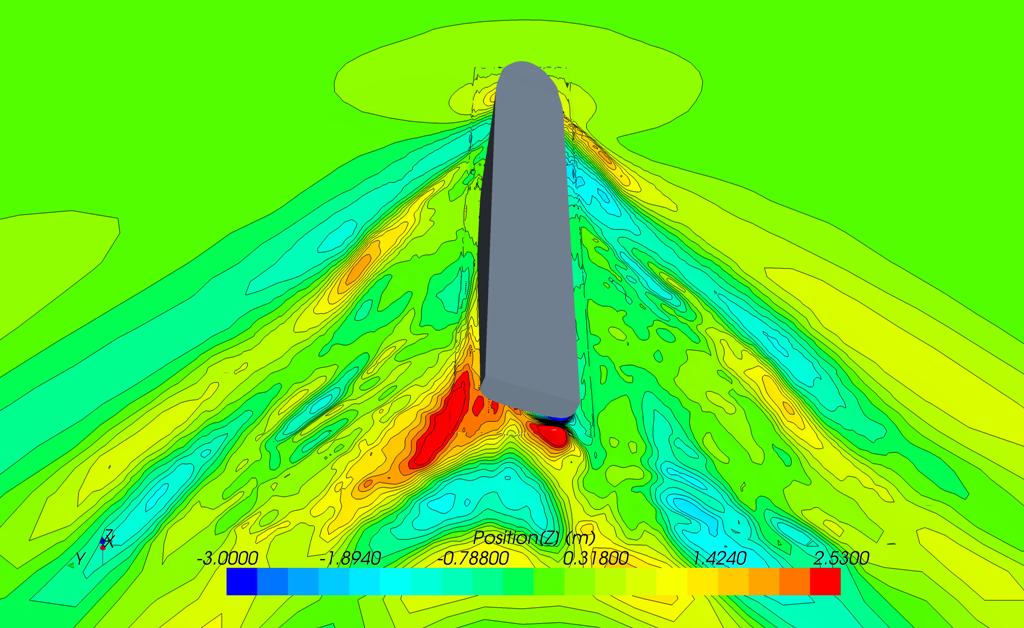

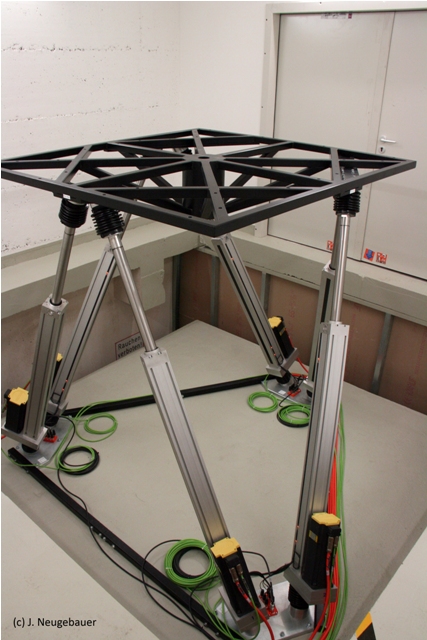 Central part of the Sloshing Laboratory is a Stewart-Platform, also known as Hexapod, where experimental tank cavities can be mounted and moved within six Degrees of Freedom (DoF). A large number of pressure sensors is available and can be acquired simultaneously at high sampling rates. In order to perform non-intrusive measurements of the flow inside a tank cavity, a time-resolved stereoscopic Particle-Image-Velocity System is used.
Central part of the Sloshing Laboratory is a Stewart-Platform, also known as Hexapod, where experimental tank cavities can be mounted and moved within six Degrees of Freedom (DoF). A large number of pressure sensors is available and can be acquired simultaneously at high sampling rates. In order to perform non-intrusive measurements of the flow inside a tank cavity, a time-resolved stereoscopic Particle-Image-Velocity System is used.

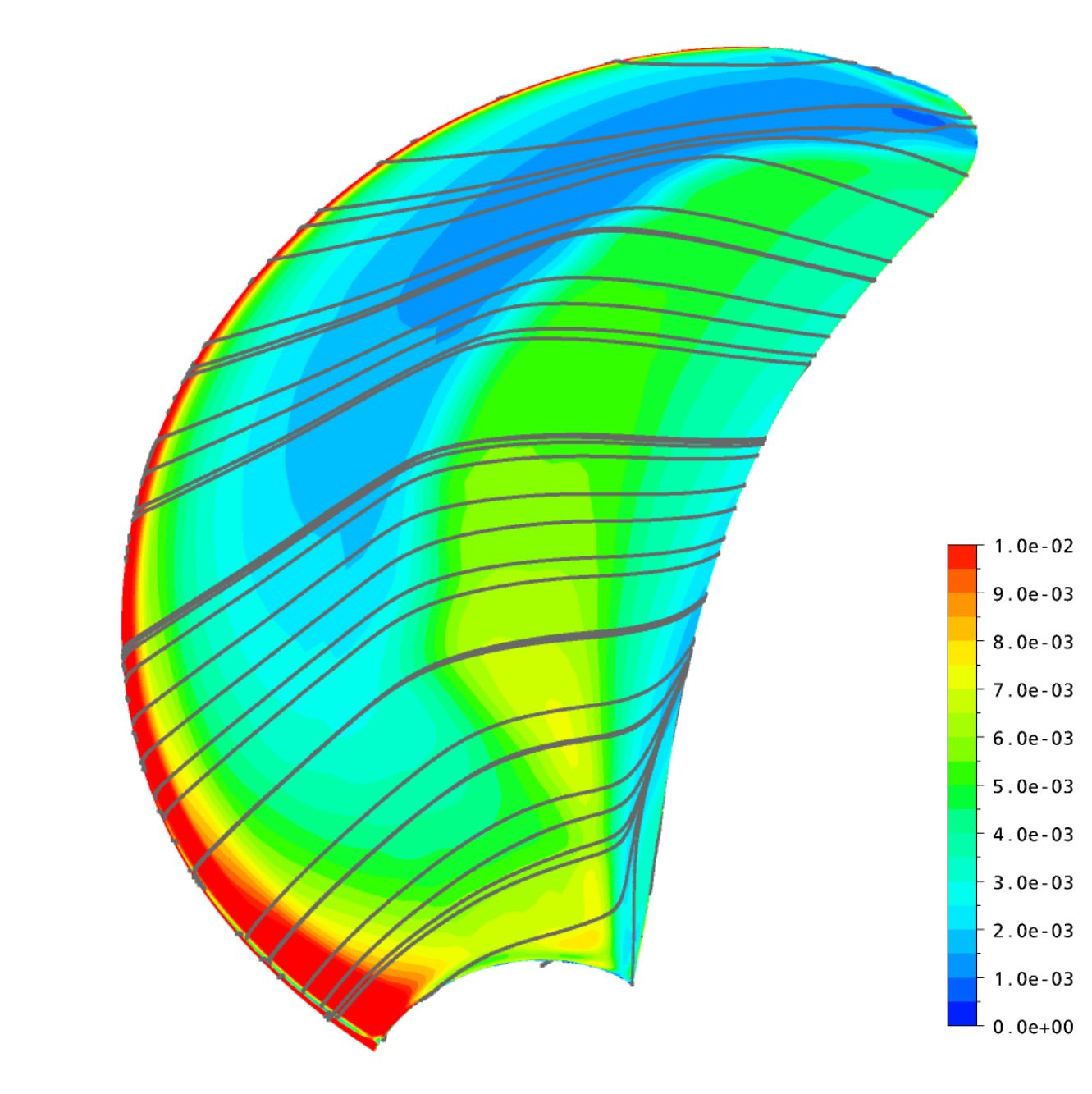
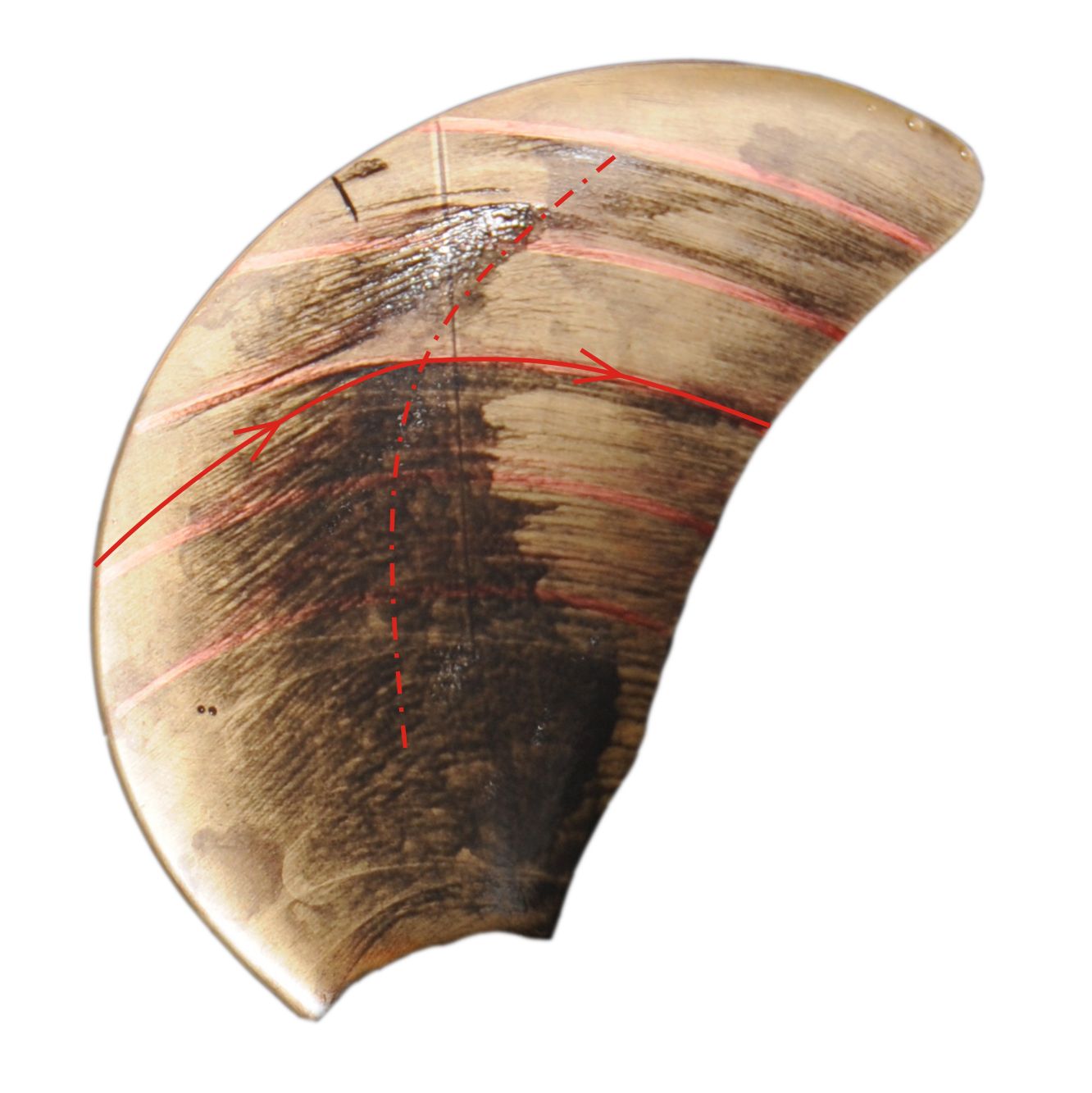
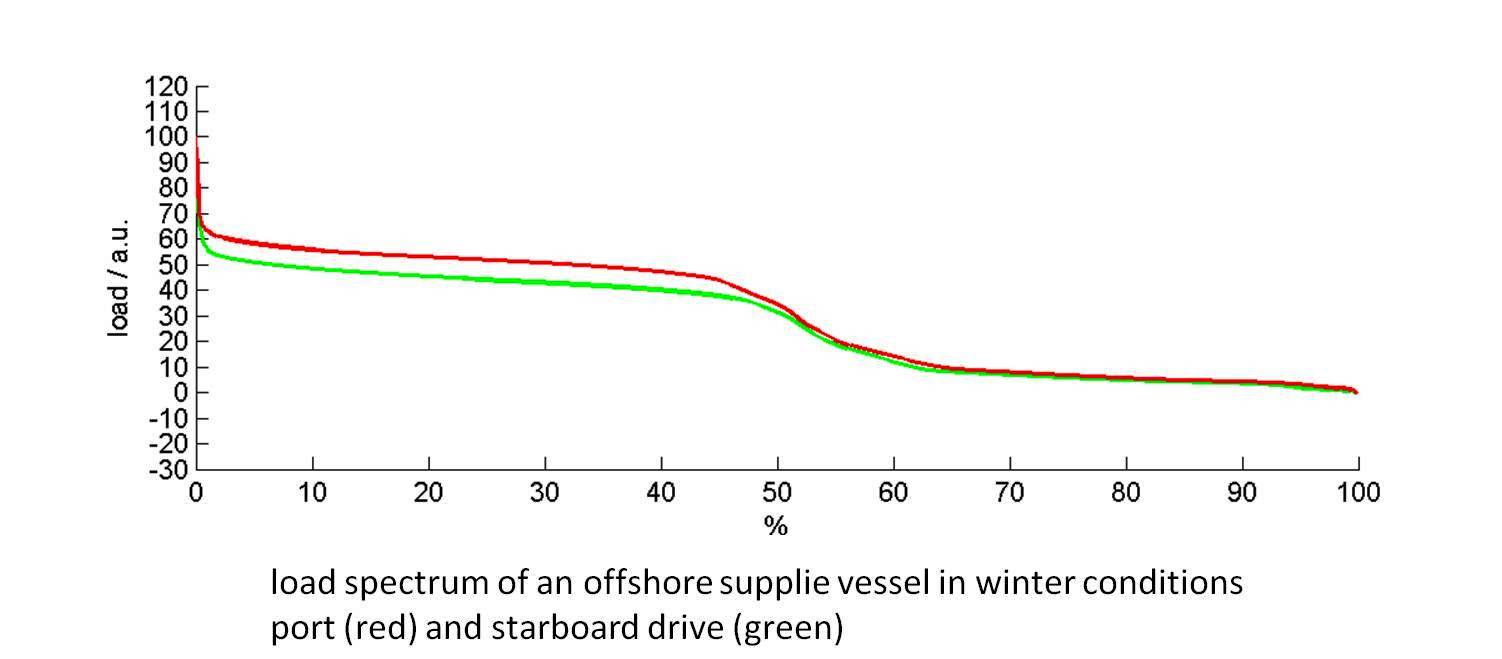
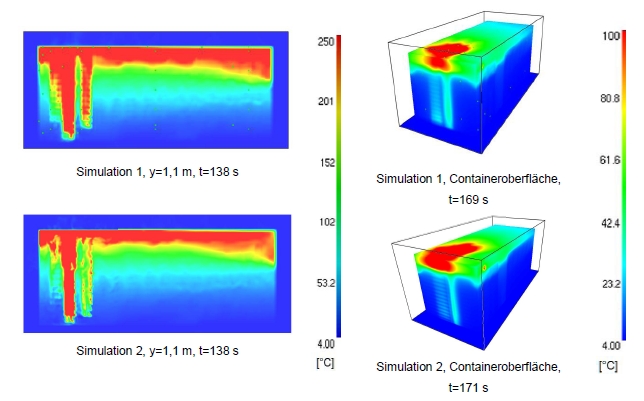
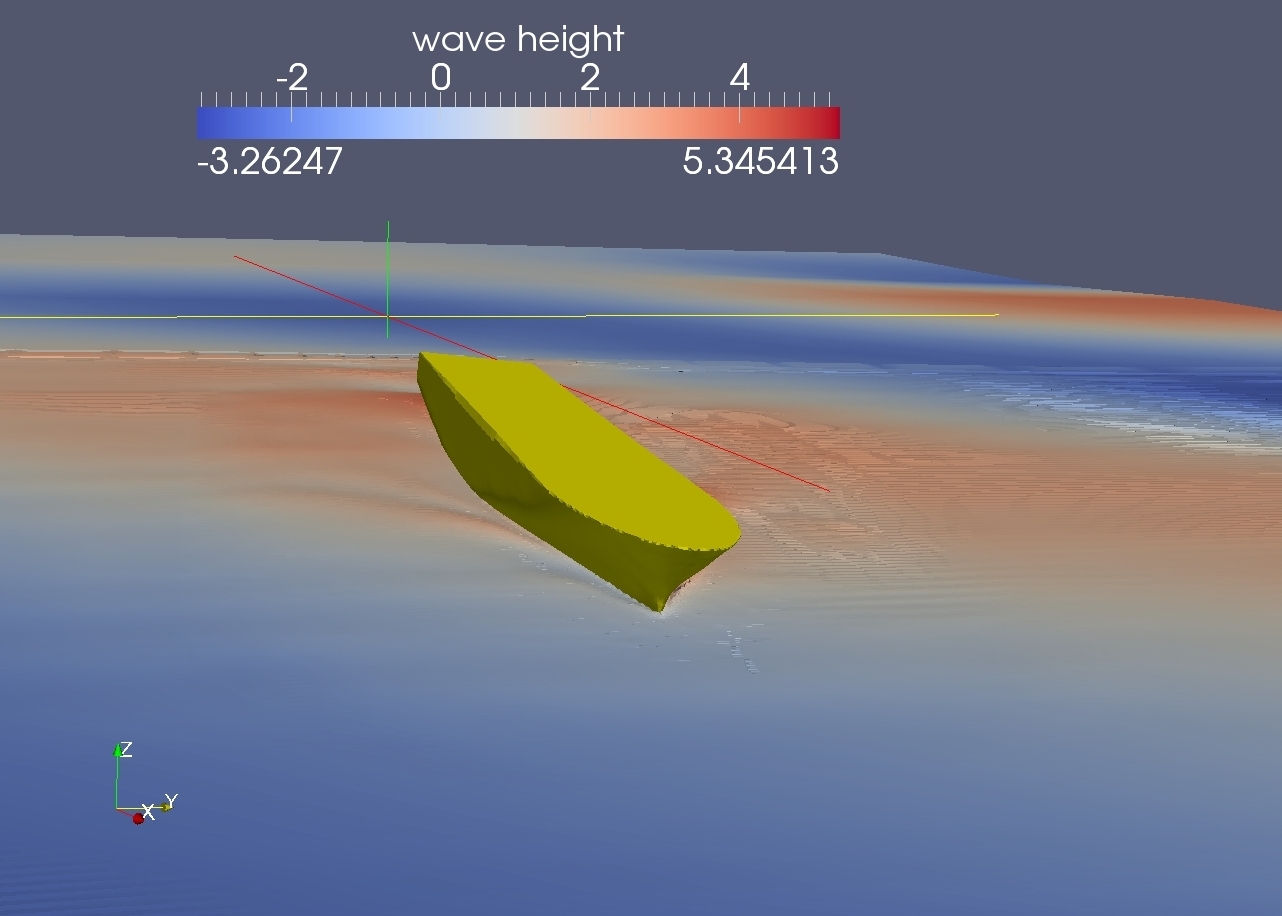
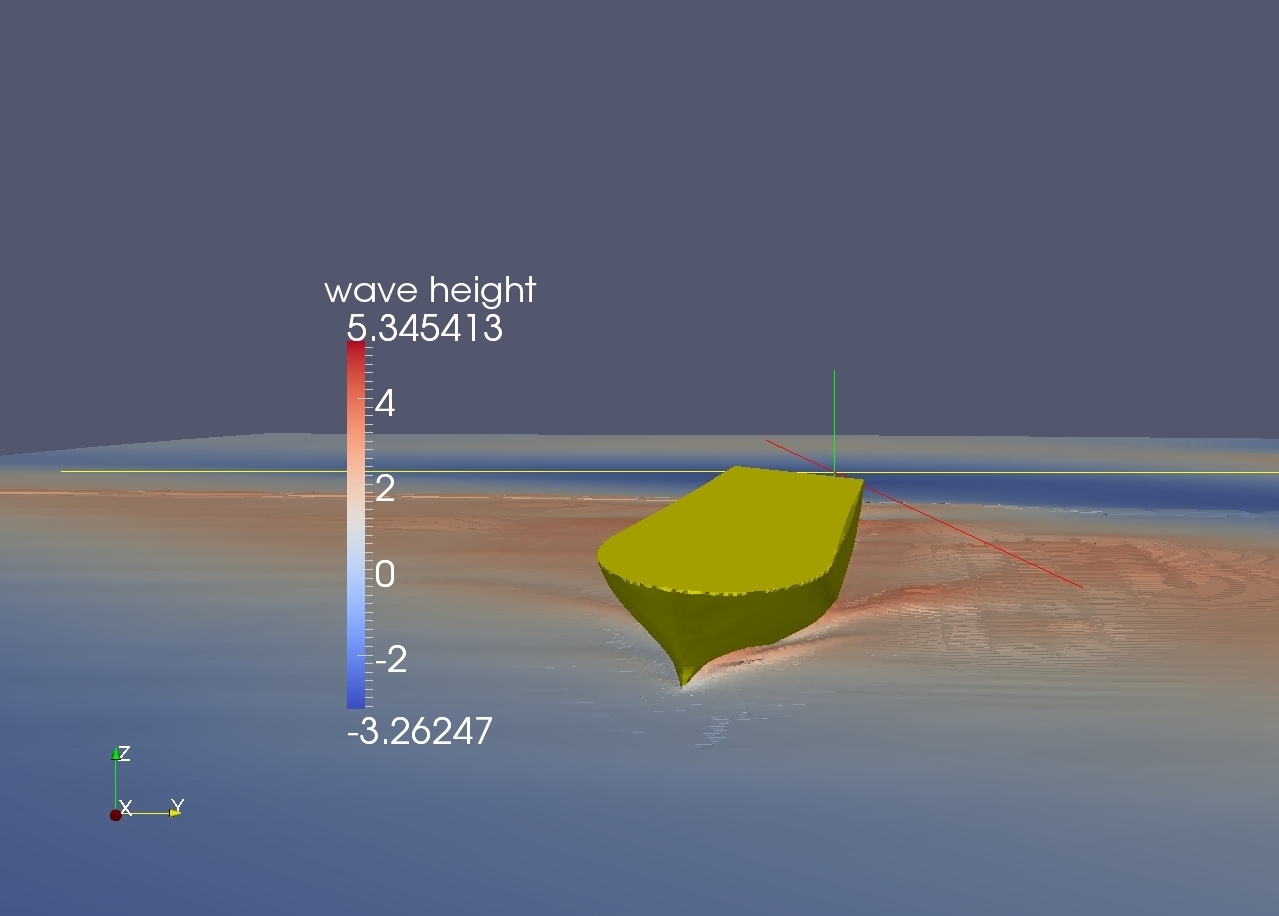
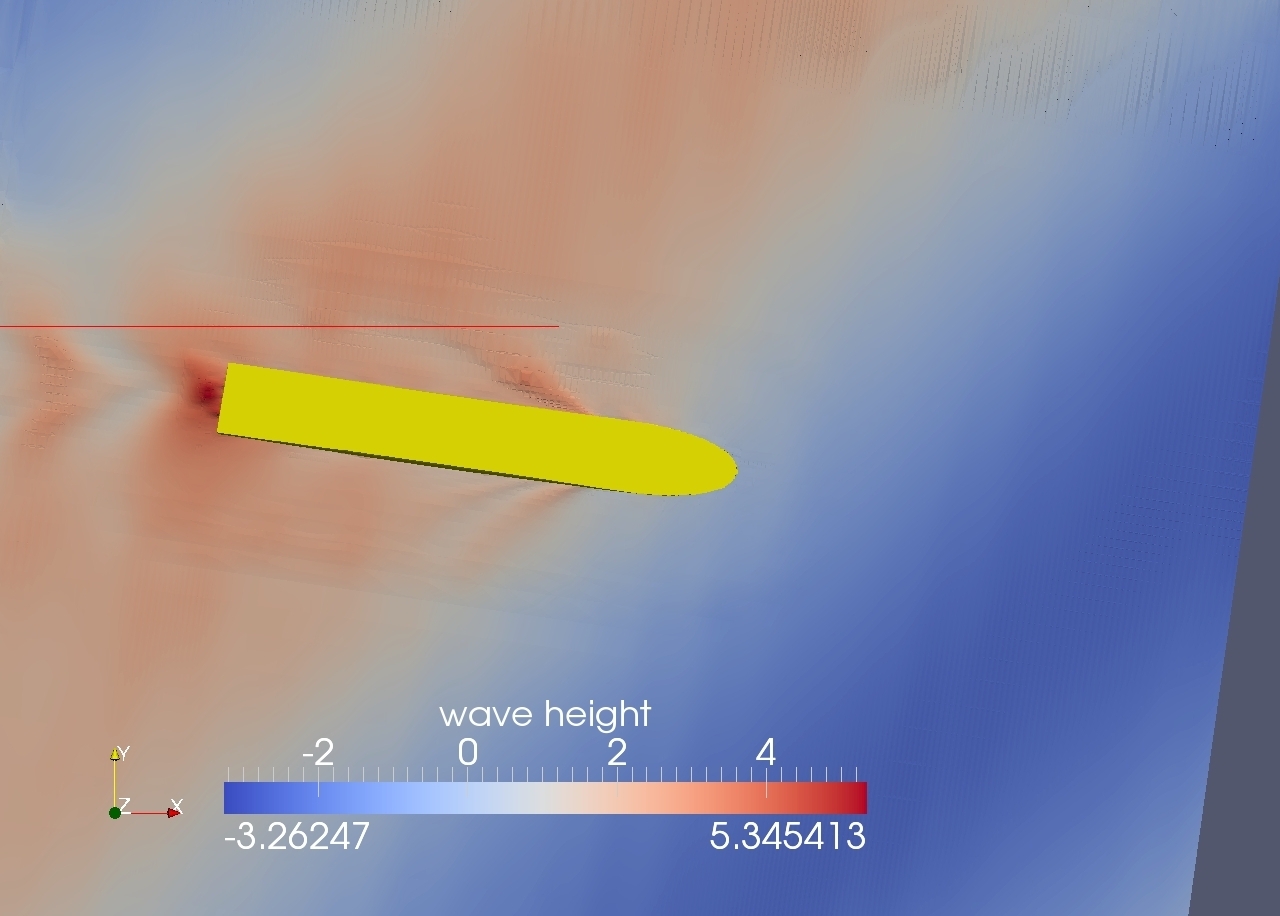

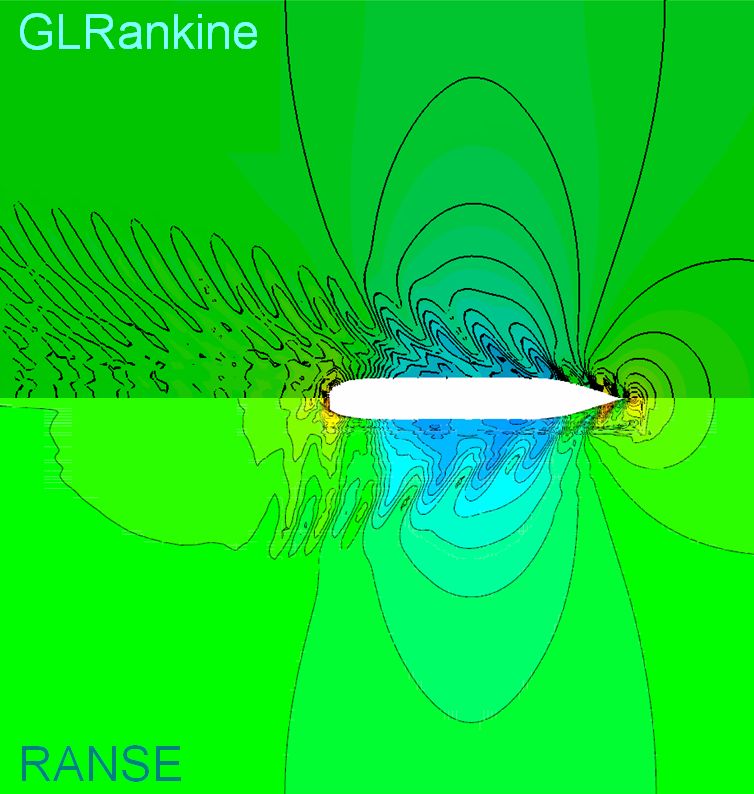 Water is considered as an ideal fluid (invicid, incompressible, irrotational). In both cases the Laplace equation with the corresponding boundary conditions is solved using a boundary element method (Rankine method) to calculate the velocity potential. For the stationary part, the boundary conditions at the free surface are treated 'fully nonlinear' using an iterative method. Based on the stationary solution, a perturbation formulation is used for the calculation of the periodical solution. Boundary conditions are linearised to make computations more efficient in the frequency domain. Based on the existing code, the method shall be evaluated and improved, concerning mainly numerical and algorithmic aspects.
Water is considered as an ideal fluid (invicid, incompressible, irrotational). In both cases the Laplace equation with the corresponding boundary conditions is solved using a boundary element method (Rankine method) to calculate the velocity potential. For the stationary part, the boundary conditions at the free surface are treated 'fully nonlinear' using an iterative method. Based on the stationary solution, a perturbation formulation is used for the calculation of the periodical solution. Boundary conditions are linearised to make computations more efficient in the frequency domain. Based on the existing code, the method shall be evaluated and improved, concerning mainly numerical and algorithmic aspects.